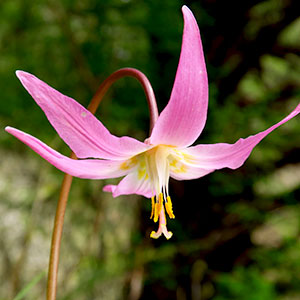Erythronium revolutum
Erythronium propullans
coast fawn lily, mahogany fawn lily, pink fawn-lily
Minnesota dwarf trout-lily, Minnesota fawnlily, Minnesota trout lily
narrowly ovoid, 35–50 mm, sometimes producing sessile offsets.
ovoid, 10–25 mm;
stolon 1 in flowering plants, arising from halfway up stem, 1–3 from bulbs of 1-leaved, nonflowering plants.
10–25 mm;
blade distinctly mottled with irregular streaks of brown or white, broadly lanceolate to ovate, margins entire to ± wavy.
4–13 cm;
blade green, irregularly mottled, elliptic-lanceolate to ovate-lanceolate or elliptic, ± flat, glaucous, margins entire.
15–40 cm.
3.9–12 cm.
1–3-flowered.
1-flowered.
tepals uniformly clear violet-pink at anthesis, with yellow banding at base, lanceolate to narrowly elliptic, 25–40 mm, inner with small auricles at base;
stamens ± appressed to style, 12–22 mm;
filaments white to pink (darkening with age), flattened, ± lanceolate, 2–3 mm wide;
anthers bright yellow;
style white to pink, 12–18 mm;
stigma with slender recurved lobes 4–6 mm.
tepals 4–6, strongly reflexed at anthesis, pale pink to white, darker abaxially, lanceolate, 8–15 mm, auricles absent;
stamens 2–6, 6–8 mm;
filaments white, lanceolate;
anthers yellow;
pollen yellow;
style white, 6–10 mm;
stigma ± unlobed.
oblong to obovoid, 3–6 cm.
very rarely produced; when present, may be result of hybridization with Erythronium albidum.
Erythronium revolutum
Erythronium propullans
Of conservation concern.
Erythronium propullans is known only from Goodhue and Rice counties. It often forms extensive colonies in which flowering plants are sometimes more abundant than nonflowering, 1-leaved ones, and sometimes the reverse. It grows mixed with E. albidum (J. A. Banks 1980), and putative hybrids between them have been reported (T. Morley 1988). Flowers frequently have fewer than six tepals and stamens (C. O. Rosendahl 1919), and may occasionally have only two carpels.
(Discussion copyrighted by Flora of North America; reprinted with permission.)
- Local floras:
BC,
CA,
OR,
WA
- Local Web sites:
CalFlora,
CalPhotos,
Flora NW,
PNW Herbaria,
Turner Photog.
WildflowerSearch
iNaturalist (observations)
USDA Plants Database
- LBJ Wildflower Center
- SEINet
- Plants of the World Online
- Encyclopedia of Life
- Wikipedia
- Google Image Search


